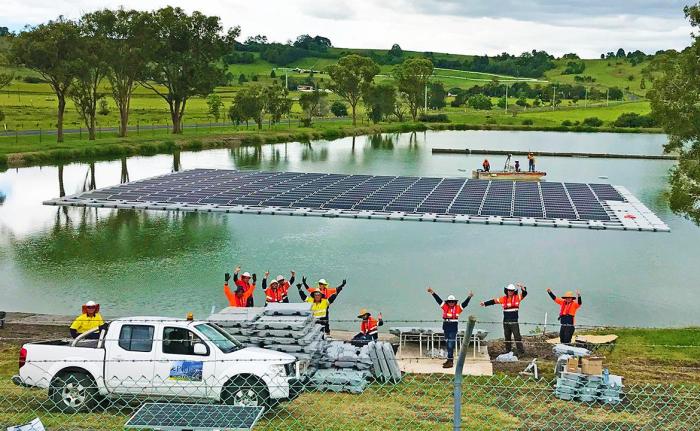
Lismore’s floating solar farm while under construction | Image: Ciel & Terre
The opening of Australia’s largest floating solar farm is serving as a backdrop for the welcoming of dozens of councils throughout Australia to the Climate Council’s Cities Power Partnership.
Councils joining the partnership pledge to take five key actions across renewable energy, efficiency, transport and collaboration. Power Partners get free access to a knowledge hub to assist with projects and analytics tools to help track emissions, energy and costs savings. Partners are also “buddied” with other participating councils.
Among those to recently join the “coalition of the willing” are Sydney, Brisbane, Darwin and Cairns councils. The new members take the number of councils participating to seventy, representing 7.5 million Australians and more than 250 towns and cities.
The full list of Power Partners can be viewed here.
“We’re excited to see a record number of councils jumping on board with the Cities Power Partnership,” said Climate Councillor Professor Will Steffen. “As the tier of government that’s closest to the community, local councils have the power to genuinely transform the way we generate and use energy.”
The Climate Council encourages residents of local government areas yet to join the program to complete a brief form and they’ll then give those councils a nudge.
“The more nominations we get from locals, the easier it is for us to get councils onboard.”
Lismore Floating Solar Project Complete
Today’s event also saw the official opening of a 99kW floating solar panel array in Lismore, NSW; a project backed by Cities Power Partnership member Lismore Council and Lismore Community Solar.
The largest operating floating solar farm in Australia currently, the system has been installed at the East Lismore Sewage Treatment Plant and will supply approximately 12% of the facility’s electricity requirements.
Construction of the facility began in November last year and is the second project under the Lismore Community Solar initiative. The first solar power system was a 99kW array installed on the roof of the Goonellabah Sports & Aquatic Centre.
“Our community is passionate about sustainability, driving the development of our new floating solar farm which we hope will inspire other councils to find local climate solutions,” said Lismore City Mayor Cr Isaac Smith.
Lismore’s Renewable Energy Master Plan sets a goal of Council self-generating all its electricity from renewable energy sources by 2023.

 RSS - Posts
RSS - Posts



Interesting the number of councils that have signed up and also those that haven’t. My local council on the Gold Coast isn’t shown as a member which doesn’t really surprise as they are to concerned in giving questionable developers unfettered access to land that the community objects to. Rooftop PV is widely installed across the GC region not surprisingly because we get great solar resources. As is usual with the GCCC the council do one thing and the residents want another.
What is the main selling point of the floating scheme?
Presumably the cost of the floating racks etc. won’t be any lower than equivalent ground-mounted racks.
Is it simply avoiding the use of otherwise productive land? Australia must have stacks of non-productive land to choose from.
In general I’m in favour of building as many solar farms as possible and using dumb, cheap technology in large volumes rather than attempting to roll out unnecessarily “smart” technology in small expensive doses (I’m looking at you, solar roads… and you, poorly-performing vertical axis wind turbines with solar panels on the blades…).
If floating farms solves a genuine problem, then anchors aweigh!
In places such as Japan and South Korea where land is at a premium and there is less roof space and sunshine per person floating arrays may make a lot of sense. In Australia it does seem a bit odd, but if you have a small water treatment plant or other facility that is paying a fairly high rate for grid electricity and there are open ponds but not land for solar then a floating array could make economic sense.
But in general, roofs make a lot more sense. But I presume floating arrays will eventually be mass produced on a large scale and get pretty cheap.
When designed properly they can reduce water loss from evaporation, but water simply isn’t expensive enough for that to be much of a consideration.
Maybe a good situation in any country where they hold large water pools or dams feeding into Hydro-electic generation systems would be compatable, as they could add to the clean energy already being produced there. Just more ‘free’ electricity into the grid.???✔⁉❔